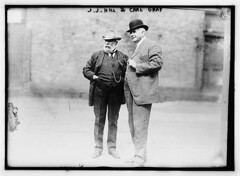Cafe Press, dot com company that provides customization services and offers to create storefronts for anyone; its a $127 million dollar business that promotes its self as "...
A key differentiator of our business model is our ability to profitably produce customized merchandise in small quantities on a when-ordered basis."
The reality is while their sales fluctuate from year to year, quarter to quarter, their profitability swings wildly between profitability and staggering losses.
Here is a video where the CEO explains the company much better than I ever could:
Now, this market is filled with a lot of competitors, Zazzle and Spreadshirt, being the most obvious, but the reality is every town has a screen printer who will provide the same services and the internet is chock full of promotional product companies that will fill in whatever else you want besides tee shirts.
At some point you have to differentiate yourself from your competition in a meaningful way,
right now Cafe Press is:
* A company with over 300 million products (that is designs) a consumer can pick from.
* These 300 million designs can be ordered on over 600 product SKU's (from apparel and
drinkware to posters, electronic accessories, and more....
* They have over 2 million shops and they receive over 135,000 new designs every week.
* If by some odd chance you cannot find what you want you can create your own with
there online design tool.
* Over 11 million unique visitors a month to their website and they ship 6 million products
year.
In 2010 Cafe Press had 2 million customers, shipped 2.7 million orders, with an average order size of $47.
So, to grow their business they are testing a
"kiosk" at Western Kentucky University. Now, for the retailers perspective this is not a bad idea; a customer comes in, sits down at a computer in the kiosk and designs and orders something. They then pay the retailer and in a few days the consumer can return to the bookstore and pick up their order. It brings the retailer a second visit from the consumer and it saves the consumer shipping.
But, why would anyone, with a computer and internet access, feel compelled to visit a college bookstore to design and place an order with Cafe Press?
If a company, such as
Shapeways, were to establish kiosks on college campuses that would be a brilliant idea because they have something that is relatively new to the consumer market, its something that is not all that well known nor understood, thus the exposure on college campuses would make logical sense.
But for a company like Cafe Press, it really seems like nothing more than a duplication of something they already provide. Now, Western Kentucky University's bookstore, has decided to take this Cafe Press Kiosk and create their own, on campus,
"Threadless" community by holding
weekly tee shirt design contests.
Thus the concept of a "kiosk" or a "store within a store" is basically the first volley of Cafe Press to create a Threadless community on every college campus where it can gain entry to the college bookstore! Campus groups competing in design contests against each other which will eventually lead to college design teams competing against other college design teams! Obviously, Western Kentucky University was chosen because Cafe Press has offices and manufacturing facilities in Louisville, Kentucky and Western is the only university in the state that has an independent bookstore.
The reality is that its not the kiosk that will create the demand but rather the community that creates the demand; is there an existing community that wants this opportunity? If there is its probably safe to assume that they are already part of the Threadless community and right now there is
no established Threadfan community in Bowling Green, Kentucky.
I am a big fan of
interactive kiosks, shops within shops, and pop up shops, and I believe that internet brands and retailers will eventually have to develop the ability to integrate on line with off line. But, I think Cafe Press needs to to realize that a kiosk can also be nothing more than a duplication of something readily available without a more obvious strategy; and they need a strategy which reduces their products/designs, reduces their SKU's, and increases the dollar value of their average order.



.jpg)










